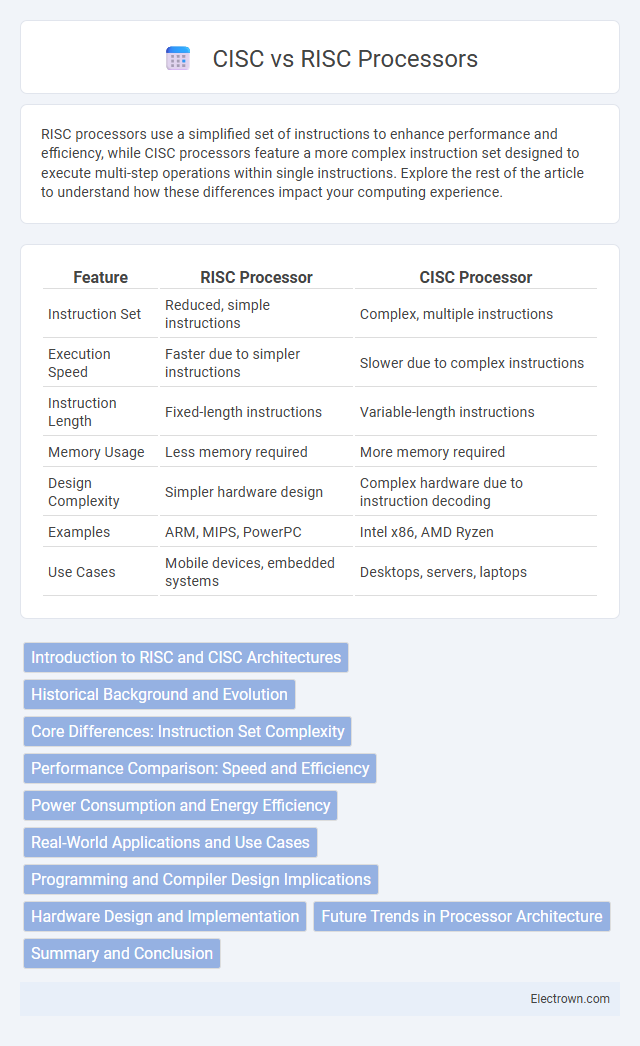RISC processors use a simplified set of instructions to enhance performance and efficiency, while CISC processors feature a more complex instruction set designed to execute multi-step operations within single instructions. Explore the rest of the article to understand how these differences impact your computing experience.
Table of Comparison
| Feature | RISC Processor | CISC Processor |
|---|---|---|
| Instruction Set | Reduced, simple instructions | Complex, multiple instructions |
| Execution Speed | Faster due to simpler instructions | Slower due to complex instructions |
| Instruction Length | Fixed-length instructions | Variable-length instructions |
| Memory Usage | Less memory required | More memory required |
| Design Complexity | Simpler hardware design | Complex hardware due to instruction decoding |
| Examples | ARM, MIPS, PowerPC | Intel x86, AMD Ryzen |
| Use Cases | Mobile devices, embedded systems | Desktops, servers, laptops |
Introduction to RISC and CISC Architectures
RISC (Reduced Instruction Set Computer) processors emphasize a simplified set of instructions designed for faster execution and efficient pipeline processing, typically featuring fixed-length instructions that enable easier decoding. CISC (Complex Instruction Set Computer) processors contain a broader and more complex set of instructions, often variable in length, allowing them to perform multiple low-level operations within a single instruction, which can reduce code size. The fundamental difference lies in RISC's focus on speed and simplicity versus CISC's aim to minimize the number of instructions per program by increasing instruction complexity.
Historical Background and Evolution
RISC (Reduced Instruction Set Computing) processors emerged in the 1980s as a response to the complexity and inefficiencies of CISC (Complex Instruction Set Computing) architectures, which dominated earlier computing with their extensive and intricate instruction sets. The evolution of RISC focused on simplifying instructions to enhance performance through faster execution and pipeline efficiency, influencing major processors like ARM and MIPS. Meanwhile, CISC processors evolved by integrating advanced features such as microcode and multiple execution units to improve performance while maintaining backward compatibility with legacy software.
Core Differences: Instruction Set Complexity
RISC processors utilize a simplified instruction set with fixed-length instructions designed for rapid execution, enabling efficient pipeline processing and higher performance per clock cycle. CISC processors feature a complex instruction set with variable-length instructions, allowing a single instruction to execute multiple low-level operations, which can reduce the number of instructions per program. Understanding the core differences in instruction set complexity helps you choose the right architecture for optimizing software performance and hardware compatibility.
Performance Comparison: Speed and Efficiency
RISC processors achieve higher speed and efficiency by executing a smaller number of simple instructions per cycle, enabling faster instruction throughput and reduced latency. CISC processors handle complex instructions that perform multiple operations, which may slow clock speed but reduce code size, impacting performance trade-offs. Your choice between RISC and CISC should consider the specific workload requirements, balancing speed and efficiency for optimal system performance.
Power Consumption and Energy Efficiency
RISC processors typically consume less power due to their simplified instruction set, which allows for faster execution with fewer clock cycles per instruction. In contrast, CISC processors perform more complex instructions that can lead to higher energy consumption and increased heat generation. Your choice between RISC and CISC can significantly impact energy efficiency, especially in battery-powered or energy-sensitive applications.
Real-World Applications and Use Cases
RISC processors dominate in mobile devices and embedded systems due to their energy efficiency and simplified instruction sets, driving performance in smartphones, tablets, and IoT devices. CISC processors excel in desktop computers and servers where complex instructions improve software compatibility and multitasking capabilities, supporting heavy workloads like gaming, video editing, and enterprise applications. Understanding these use cases helps you select the right processor architecture for performance or energy efficiency based on your specific technology needs.
Programming and Compiler Design Implications
RISC processors use simpler instruction sets that enable more efficient pipelining and easier instruction scheduling, which simplifies compiler design and improves code optimization. CISC processors, with their complex instructions, require compilers to handle variable-length instructions and perform intricate decoding, often increasing compiler complexity and potential for slower instruction throughput. Programming for RISC architectures generally demands more instructions but benefits from predictable execution patterns, whereas CISC programming can exploit powerful single instructions at the cost of less transparent control flow for compilers.
Hardware Design and Implementation
RISC processors feature a simplified hardware design with a fixed instruction length and a limited set of instructions, enabling faster instruction execution and easier pipeline implementation. CISC processors have complex hardware capable of executing multi-step instructions within a single command, utilizing variable-length instructions and microcode control units. The streamlined architecture of RISC reduces transistor count and power consumption, while CISC designs integrate advanced decoding and execution units to handle complex instructions efficiently.
Future Trends in Processor Architecture
RISC processors prioritize simplified instruction sets for faster execution while CISC processors focus on complex instructions to reduce program length, shaping distinct future trends in processor architecture. Emerging designs increasingly blend RISC efficiency with CISC capabilities, leveraging advancements in machine learning and AI optimization to enhance performance and energy efficiency. Your computing experience will benefit from these hybrid architectures, which drive innovation for both mobile and high-performance applications.
Summary and Conclusion
RISC processors emphasize a small set of simple instructions executed within a single clock cycle, enhancing performance and power efficiency for applications requiring fast, predictable processing. In contrast, CISC processors use a larger set of complex instructions, enabling easier programming and reduced code size but often at the cost of increased power consumption and slower instruction execution. Choosing between RISC and CISC depends on specific use cases, with RISC favored in mobile, embedded, and high-performance computing, while CISC remains prevalent in desktop computing and legacy systems.
RISC vs CISC processors Infographic

 electrown.com
electrown.com